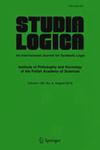Non-Reflexive Nonsense: Proof Theory of Paracomplete Weak Kleene Logic
IF 0.6
3区 数学
Q2 LOGIC
引用次数: 0
Abstract
Our aim is to provide a sequent calculus whose external consequence relation coincides with the three-valued paracomplete logic ‘of nonsense’ introduced by Dmitry Bochvar and, independently, presented as the weak Kleene logic \(\textbf{K}_{\textbf{3}}^{\textbf{w}}\) by Stephen C. Kleene. The main features of this calculus are (i) that it is non-reflexive, i.e., Identity is not included as an explicit rule (although a restricted form of it with premises is derivable); (ii) that it includes rules where no variable-inclusion conditions are attached; and (iii) that it is hybrid, insofar as it includes both left and right operational introduction as well as elimination rules.
非反身胡言乱语:准完全弱克莱因逻辑的证明理论
摘要 我们的目的是提供一种时序微积分,它的外部结果关系与德米特里-波赫瓦尔(Dmitry Bochvar)提出的三值准完全逻辑 "无稽之谈"(of nonsense)相吻合,并由斯蒂芬-克莱因(Stephen C. Kleene)作为弱克莱因逻辑(\textbf{K}_{\textbf{3}}^{textbf{w}}/\)独立提出。Kleene.这种微积分的主要特点是:(i) 它是非反身的,即 "同一性"(Identity)不作为显式规则(尽管它的一种带前提的限制形式是可推导的);(ii) 它包括不附加变量包含条件的规则;(iii) 它是混合的,因为它既包括左运算引入规则,也包括右运算引入规则,还包括消元规则。
本文章由计算机程序翻译,如有差异,请以英文原文为准。
求助全文
约1分钟内获得全文
求助全文
来源期刊

Studia Logica
MATHEMATICS-LOGIC
CiteScore
1.70
自引率
14.30%
发文量
43
审稿时长
6-12 weeks
期刊介绍:
The leading idea of Lvov-Warsaw School of Logic, Philosophy and Mathematics was to investigate philosophical problems by means of rigorous methods of mathematics. Evidence of the great success the School experienced is the fact that it has become generally recognized as Polish Style Logic. Today Polish Style Logic is no longer exclusively a Polish speciality. It is represented by numerous logicians, mathematicians and philosophers from research centers all over the world.
 求助内容:
求助内容: 应助结果提醒方式:
应助结果提醒方式:


